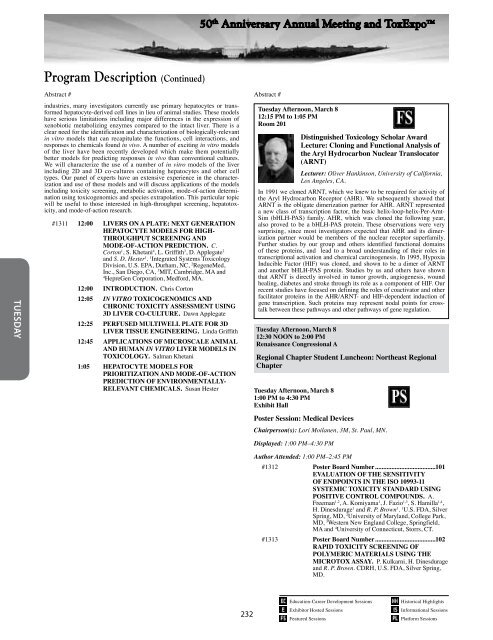Program - Society of Toxicology
Program - Society of Toxicology
Program - Society of Toxicology
You also want an ePaper? Increase the reach of your titles
YUMPU automatically turns print PDFs into web optimized ePapers that Google loves.
50 th Anniversary Annual Meeting and ToxExpo<br />
<strong>Program</strong> Description (Continued)<br />
Tuesday<br />
Abstract # Abstract #<br />
industries, many investigators currently use primary hepatocytes or transformed<br />
hepatocyte-derived cell lines in lieu <strong>of</strong> animal studies. These models<br />
have serious limitations including major differences in the expression <strong>of</strong><br />
xenobiotic metabolizing enzymes compared to the intact liver. There is a<br />
clear need for the identification and characterization <strong>of</strong> biologically-relevant<br />
in vitro models that can recapitulate the functions, cell interactions, and<br />
responses to chemicals found in vivo. A number <strong>of</strong> exciting in vitro models<br />
<strong>of</strong> the liver have been recently developed which make them potentially<br />
better models for predicting responses in vivo than conventional cultures.<br />
We will characterize the use <strong>of</strong> a number <strong>of</strong> in vitro models <strong>of</strong> the liver<br />
including 2D and 3D co-cultures containing hepatocytes and other cell<br />
types. Our panel <strong>of</strong> experts have an extensive experience in the characterization<br />
and use <strong>of</strong> these models and will discuss applications <strong>of</strong> the models<br />
including toxicity screening, metabolic activation, mode-<strong>of</strong>-action determination<br />
using toxicogenomics and species extrapolation. This particular topic<br />
will be useful to those interested in high-throughput screening, hepatotoxicity,<br />
and mode-<strong>of</strong>-action research.<br />
#1311 12:00 LIVERS ON A PLATE: NEXT GENERATION<br />
HEPATOCYTE MODELS FOR HIGH-<br />
THROUGHPUT SCREENING AND<br />
MODE-OF-ACTION PREDICTION. C.<br />
Corton 1 , S. Khetani 4 , L. Griffith 3 , D. Applegate 2<br />
and S. D. Hester 1 . 1 Integrated Systems <strong>Toxicology</strong><br />
Division, U.S. EPA, Durham, NC, 2 RegeneMed,<br />
Inc., San Diego, CA, 3 MIT, Cambridge, MA and<br />
4<br />
HepreGen Corporation, Medford, MA.<br />
12:00 INTRODUCTION. Chris Corton<br />
12:05 IN VITRO TOXICOGENOMICS AND<br />
CHRONIC TOXICITY ASSESSMENT USING<br />
3D LIVER CO-CULTURE. Dawn Applegate<br />
12:25 PERFUSED MULTIWELL PLATE FOR 3D<br />
LIVER TISSUE ENGINEERING. Linda Griffith<br />
12:45 APPLICATIONS OF MICROSCALE ANIMAL<br />
AND HUMAN IN VITRO LIVER MODELS IN<br />
TOXICOLOGY. Salman Khetani<br />
1:05 HEPATOCYTE MODELS FOR<br />
PRIORITIZATION AND MODE-OF-ACTION<br />
PREDICTION OF ENVIRONMENTALLY-<br />
RELEVANT CHEMICALS. Susan Hester<br />
Tuesday Afternoon, March 8<br />
12:15 PM to 1:05 PM<br />
Room 201<br />
Distinguished <strong>Toxicology</strong> Scholar Award<br />
Lecture: Cloning and Functional Analysis <strong>of</strong><br />
the Aryl Hydrocarbon Nuclear Translocator<br />
(ARNT)<br />
Lecturer: Oliver Hankinson, University <strong>of</strong> California,<br />
Los Angeles, CA.<br />
In 1991 we cloned ARNT, which we knew to be required for activity <strong>of</strong><br />
the Aryl Hydrocarbon Receptor (AHR). We subsequently showed that<br />
ARNT is the obligate dimerization partner for AHR. ARNT represented<br />
a new class <strong>of</strong> transcription factor, the basic helix-loop-helix-Per-Arnt-<br />
Sim (bHLH-PAS) family. AHR, which was cloned the following year,<br />
also proved to be a bHLH-PAS protein. These observations were very<br />
surprising, since most investigators expected that AHR and its dimerization<br />
partner would be members <strong>of</strong> the nuclear receptor superfamily.<br />
Further studies by our group and others identified functional domains<br />
<strong>of</strong> these proteins, and lead to a broad understanding <strong>of</strong> their roles in<br />
transcriptional activation and chemical carcinogenesis. In 1995, Hypoxia<br />
Inducible Factor (HIF) was cloned, and shown to be a dimer <strong>of</strong> ARNT<br />
and another bHLH-PAS protein. Studies by us and others have shown<br />
that ARNT is directly involved in tumor growth, angiogenesis, wound<br />
healing, diabetes and stroke through its role as a component <strong>of</strong> HIF. Our<br />
recent studies have focused on defining the roles <strong>of</strong> coactivator and other<br />
facilitator proteins in the AHR/ARNT- and HIF-dependent induction <strong>of</strong><br />
gene transcription. Such proteins may represent nodal points for crosstalk<br />
between these pathways and other pathways <strong>of</strong> gene regulation.<br />
Tuesday Afternoon, March 8<br />
12:30 NOON to 2:00 PM<br />
Renaissance Congressional A<br />
Regional Chapter Student Luncheon: Northeast Regional<br />
Chapter<br />
Tuesday Afternoon, March 8<br />
1:00 PM to 4:30 PM<br />
Exhibit Hall<br />
Poster Session: Medical Devices<br />
Chairperson(s): Lori Moilanen, 3M, St. Paul, MN.<br />
Displayed: 1:00 PM–4:30 PM<br />
Author Attended: 1:00 PM–2:45 PM<br />
#1312 Poster Board Number.....................................101<br />
EVALUATION OF THE SENSITIVITY<br />
OF ENDPOINTS IN THE ISO 10993-11<br />
SYSTEMIC TOXICITY STANDARD USING<br />
POSITIVE CONTROL COMPOUNDS. A.<br />
Freeman 1,2 , A. Komiyama 1 , J. Fazio 1,3 , S. Hamilla 1,4 ,<br />
H. Dinesdurage 1 and R. P. Brown 1 . 1 U.S. FDA, Silver<br />
Spring, MD, 2 University <strong>of</strong> Maryland, College Park,<br />
MD, 3 Western New England College, Springfield,<br />
MA and 4 University <strong>of</strong> Connecticut, Storrs, CT.<br />
#1313 Poster Board Number.....................................102<br />
RAPID TOXICITY SCREENING OF<br />
POLYMERIC MATERIALS USING THE<br />
MICROTOX ASSAY. P. Kulkarni, H. Dinesdurage<br />
and R. P. Brown. CDRH, U.S. FDA, Silver Spring,<br />
MD.<br />
232<br />
Education-Career Development Sessions<br />
Exhibitor Hosted Sessions<br />
Featured Sessions<br />
Historical Highlights<br />
Informational Sessions<br />
Platform Sessions
















